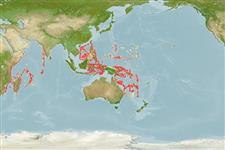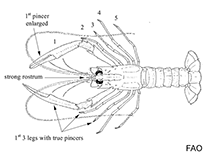Nephropsis sulcata Macpherson, 1990
Grooved lobsterette| Native range | All suitable habitat | Point map | Year 2050 |

|
| This map was computer-generated and has not yet been reviewed. |
| Nephropsis sulcata AquaMaps Data sources: GBIF OBIS |
Upload your photos
Google image | No image available for this species;
drawing shows typical species in Nephropidae.
Google image | No image available for this species;
drawing shows typical species in Nephropidae.
Classification / Names Common names | Synonyms | CoL | ITIS | WoRMS
Malacostraca | Decapoda | Nephropidae
Environment: milieu / climate zone / depth range / distribution range Ecology
Benthic; depth range 650 - 1115 m (Ref. 119191). Tropical; 22°N - 32°S, 32°E - 168°E (Ref. 4)
Distribution Countries | FAO areas | Ecosystems | Occurrences | Introductions
Southeast Atlantic and Indo-West Pacific.
Length at first maturity / Size / Weight / Age
Maturity: Lm ? range ? - ? cm Max length : 3.9 cm CL male/unsexed; (Ref. 122061); 3.8 cm CL (female)
It has lengths of 1.5 to 3 cm (male) and 1.8 to 3.4 cm (female), carapace length including rostrum; 2.6 cm, smallest ovigerous female (Ref. 4). On muddy bottoms (Ref. 4), specifically on mud flats with pumice stones at a depth of 650 m (Ref. 119191). Depth estimated based on Family.
Life cycle and mating behavior Maturity | Reproduction | Spawning | Eggs | Fecundity | Larvae
Members of the order Decapoda are mostly gonochoric. Mating behavior: Precopulatory courtship ritual is common (through olfactory and tactile cues); usually indirect sperm transfer.
Main reference
References | Coordinator | Collaborators
Holthuis, L.B. 1991. (Ref. 4)
IUCN Red List Status (Ref. 130435)
Least Concern (LC) ; Date assessed: 03 December 2009
CITES status (Ref. 108899)
Not Evaluated
CMS (Ref. 116361)
Not Evaluated
Threat to humans
Human uses
Fisheries: of no interest
| FishSource |
Tools
More information
Age/Size
Growth
Length-weight
Length-length
Morphology
Larvae
Abundance
Growth
Length-weight
Length-length
Morphology
Larvae
Abundance
Internet sources
BHL | BOLD Systems | CISTI | DiscoverLife | FAO(Publication : search) | Fishipedia | GenBank (genome, nucleotide) | GloBI | Gomexsi | Google Books | Google Scholar | Google | PubMed | Tree of Life | Wikipedia (Go, Search) | Zoological Record
Estimates based on models
Price category
(Ref. 80766):
Unknown.



